Protectionism, Trade Deficits, and Cross-Border M&A in Global Economy
VerifiedAdded on 2023/04/22
|11
|2990
|264
Essay
AI Summary
This essay examines the impact of protectionism, particularly US policies towards China, on trade deficits and the dynamics of cross-border mergers and acquisitions (M&A) in the global economy. It discusses the reasons behind the US protectionist sentiments, including the desire to reduce trade deficits, protect domestic industries, and address intellectual property theft. The analysis also covers factors influencing cross-border M&A, such as regulatory frameworks, institutional differences between countries, and the role of information costs. The essay further explores various theories explaining merger waves, including neoclassical, mis-valuation, and strategic theories. It concludes by highlighting the short-term benefits and potential long-term implications of protectionism on the US economy, emphasizing the need for a balanced approach to trade policies.
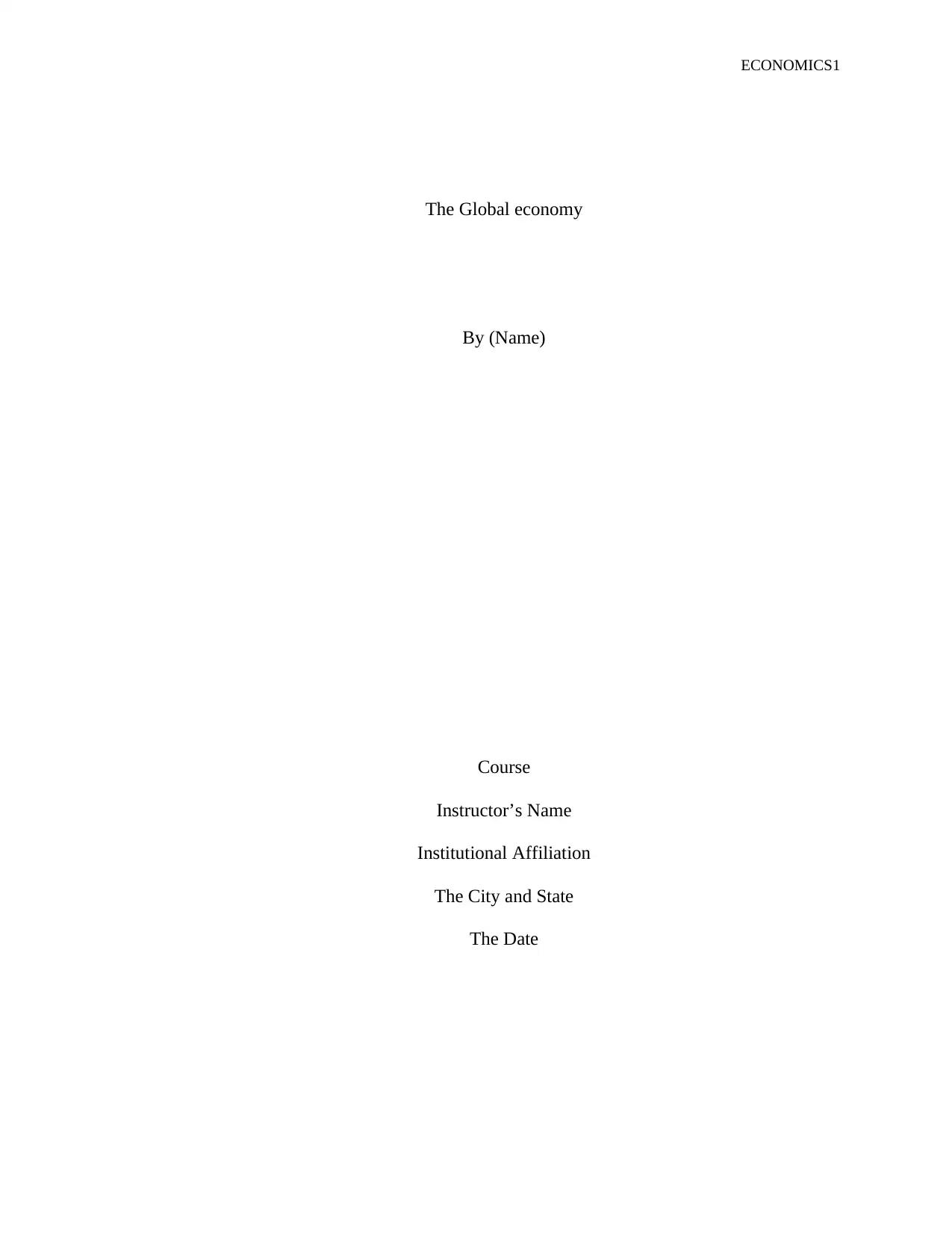
ECONOMICS1
The Global economy
By (Name)
Course
Instructor’s Name
Institutional Affiliation
The City and State
The Date
The Global economy
By (Name)
Course
Instructor’s Name
Institutional Affiliation
The City and State
The Date
Paraphrase This Document
Need a fresh take? Get an instant paraphrase of this document with our AI Paraphraser
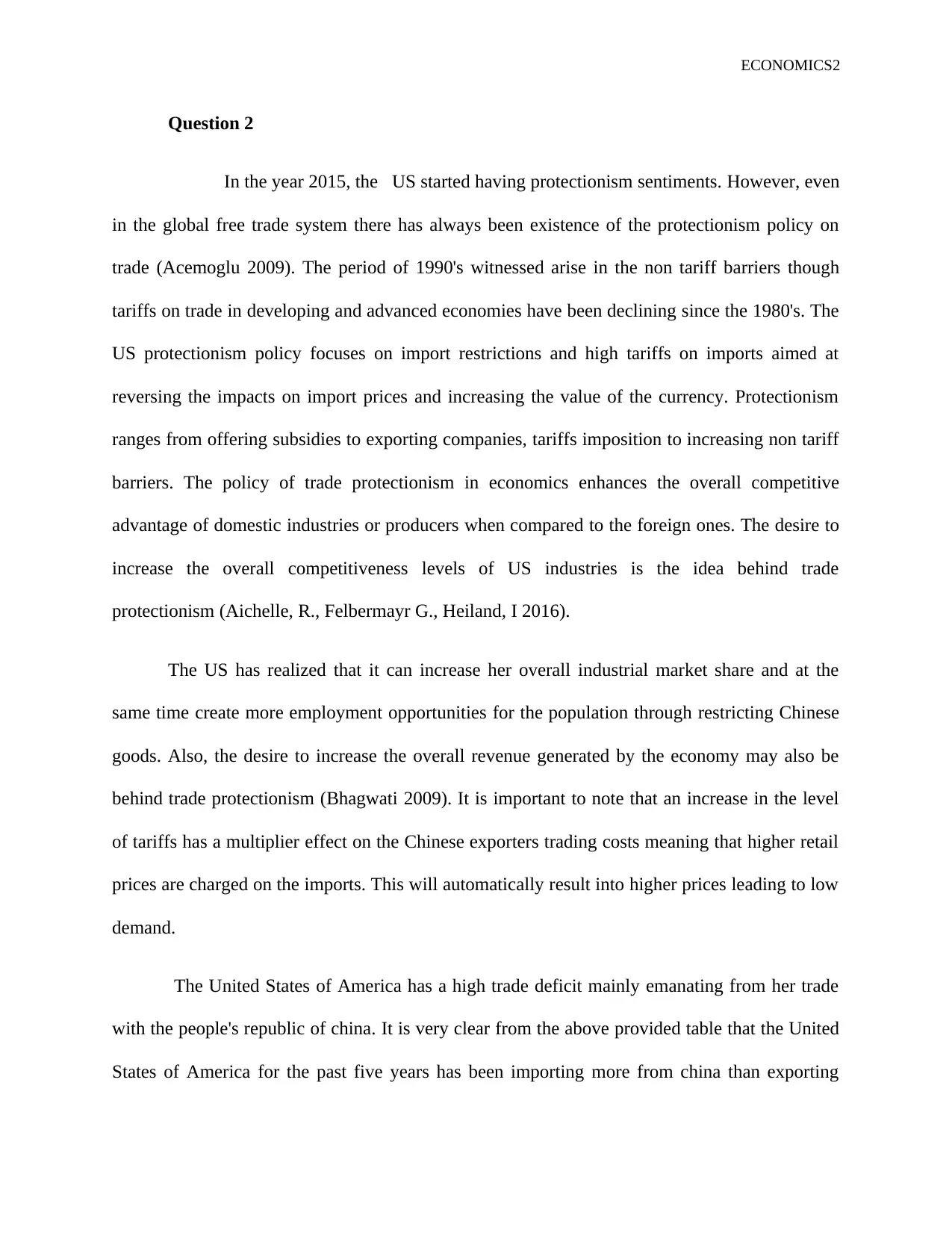
ECONOMICS2
Question 2
In the year 2015, the US started having protectionism sentiments. However, even
in the global free trade system there has always been existence of the protectionism policy on
trade (Acemoglu 2009). The period of 1990's witnessed arise in the non tariff barriers though
tariffs on trade in developing and advanced economies have been declining since the 1980's. The
US protectionism policy focuses on import restrictions and high tariffs on imports aimed at
reversing the impacts on import prices and increasing the value of the currency. Protectionism
ranges from offering subsidies to exporting companies, tariffs imposition to increasing non tariff
barriers. The policy of trade protectionism in economics enhances the overall competitive
advantage of domestic industries or producers when compared to the foreign ones. The desire to
increase the overall competitiveness levels of US industries is the idea behind trade
protectionism (Aichelle, R., Felbermayr G., Heiland, I 2016).
The US has realized that it can increase her overall industrial market share and at the
same time create more employment opportunities for the population through restricting Chinese
goods. Also, the desire to increase the overall revenue generated by the economy may also be
behind trade protectionism (Bhagwati 2009). It is important to note that an increase in the level
of tariffs has a multiplier effect on the Chinese exporters trading costs meaning that higher retail
prices are charged on the imports. This will automatically result into higher prices leading to low
demand.
The United States of America has a high trade deficit mainly emanating from her trade
with the people's republic of china. It is very clear from the above provided table that the United
States of America for the past five years has been importing more from china than exporting
Question 2
In the year 2015, the US started having protectionism sentiments. However, even
in the global free trade system there has always been existence of the protectionism policy on
trade (Acemoglu 2009). The period of 1990's witnessed arise in the non tariff barriers though
tariffs on trade in developing and advanced economies have been declining since the 1980's. The
US protectionism policy focuses on import restrictions and high tariffs on imports aimed at
reversing the impacts on import prices and increasing the value of the currency. Protectionism
ranges from offering subsidies to exporting companies, tariffs imposition to increasing non tariff
barriers. The policy of trade protectionism in economics enhances the overall competitive
advantage of domestic industries or producers when compared to the foreign ones. The desire to
increase the overall competitiveness levels of US industries is the idea behind trade
protectionism (Aichelle, R., Felbermayr G., Heiland, I 2016).
The US has realized that it can increase her overall industrial market share and at the
same time create more employment opportunities for the population through restricting Chinese
goods. Also, the desire to increase the overall revenue generated by the economy may also be
behind trade protectionism (Bhagwati 2009). It is important to note that an increase in the level
of tariffs has a multiplier effect on the Chinese exporters trading costs meaning that higher retail
prices are charged on the imports. This will automatically result into higher prices leading to low
demand.
The United States of America has a high trade deficit mainly emanating from her trade
with the people's republic of china. It is very clear from the above provided table that the United
States of America for the past five years has been importing more from china than exporting
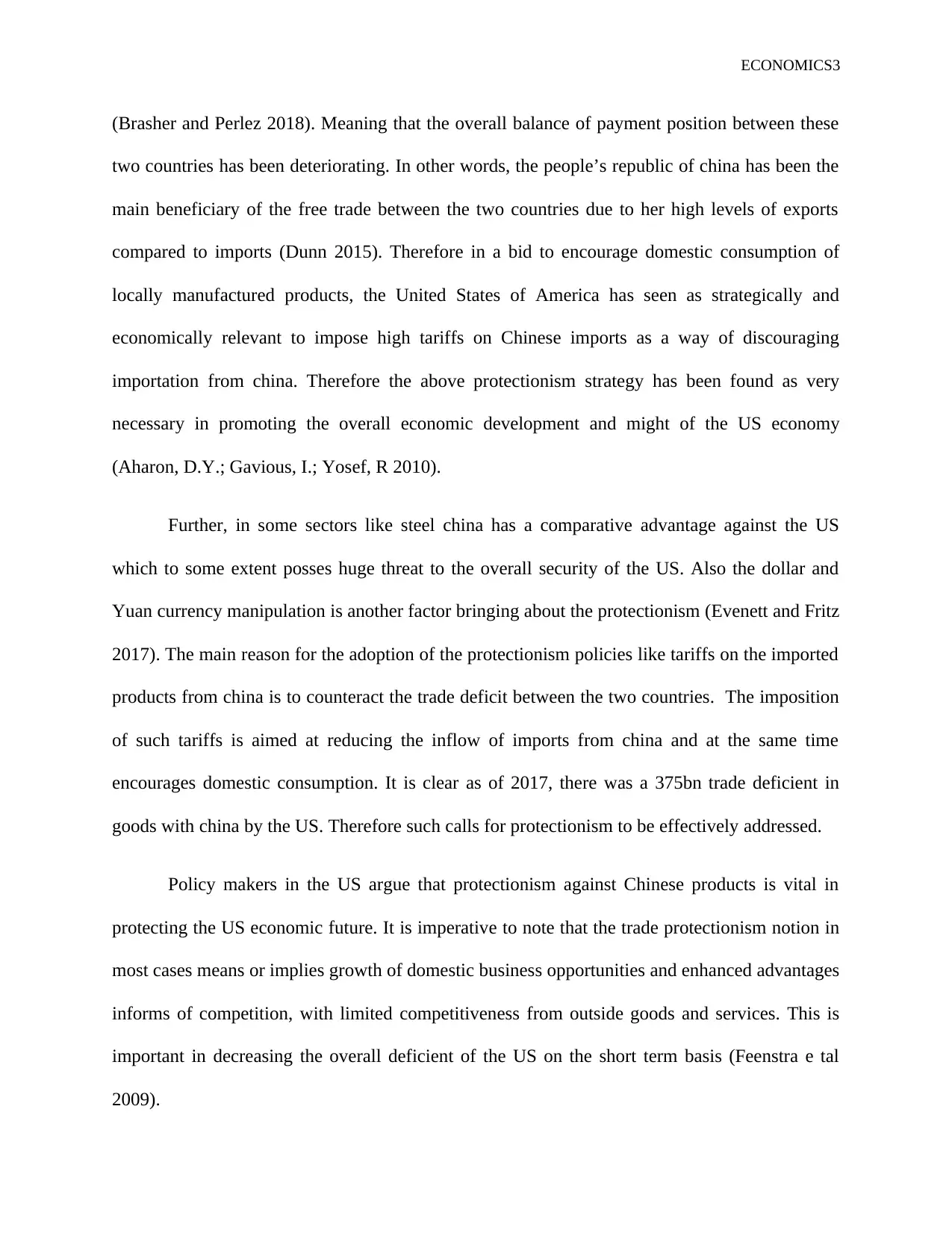
ECONOMICS3
(Brasher and Perlez 2018). Meaning that the overall balance of payment position between these
two countries has been deteriorating. In other words, the people’s republic of china has been the
main beneficiary of the free trade between the two countries due to her high levels of exports
compared to imports (Dunn 2015). Therefore in a bid to encourage domestic consumption of
locally manufactured products, the United States of America has seen as strategically and
economically relevant to impose high tariffs on Chinese imports as a way of discouraging
importation from china. Therefore the above protectionism strategy has been found as very
necessary in promoting the overall economic development and might of the US economy
(Aharon, D.Y.; Gavious, I.; Yosef, R 2010).
Further, in some sectors like steel china has a comparative advantage against the US
which to some extent posses huge threat to the overall security of the US. Also the dollar and
Yuan currency manipulation is another factor bringing about the protectionism (Evenett and Fritz
2017). The main reason for the adoption of the protectionism policies like tariffs on the imported
products from china is to counteract the trade deficit between the two countries. The imposition
of such tariffs is aimed at reducing the inflow of imports from china and at the same time
encourages domestic consumption. It is clear as of 2017, there was a 375bn trade deficient in
goods with china by the US. Therefore such calls for protectionism to be effectively addressed.
Policy makers in the US argue that protectionism against Chinese products is vital in
protecting the US economic future. It is imperative to note that the trade protectionism notion in
most cases means or implies growth of domestic business opportunities and enhanced advantages
informs of competition, with limited competitiveness from outside goods and services. This is
important in decreasing the overall deficient of the US on the short term basis (Feenstra e tal
2009).
(Brasher and Perlez 2018). Meaning that the overall balance of payment position between these
two countries has been deteriorating. In other words, the people’s republic of china has been the
main beneficiary of the free trade between the two countries due to her high levels of exports
compared to imports (Dunn 2015). Therefore in a bid to encourage domestic consumption of
locally manufactured products, the United States of America has seen as strategically and
economically relevant to impose high tariffs on Chinese imports as a way of discouraging
importation from china. Therefore the above protectionism strategy has been found as very
necessary in promoting the overall economic development and might of the US economy
(Aharon, D.Y.; Gavious, I.; Yosef, R 2010).
Further, in some sectors like steel china has a comparative advantage against the US
which to some extent posses huge threat to the overall security of the US. Also the dollar and
Yuan currency manipulation is another factor bringing about the protectionism (Evenett and Fritz
2017). The main reason for the adoption of the protectionism policies like tariffs on the imported
products from china is to counteract the trade deficit between the two countries. The imposition
of such tariffs is aimed at reducing the inflow of imports from china and at the same time
encourages domestic consumption. It is clear as of 2017, there was a 375bn trade deficient in
goods with china by the US. Therefore such calls for protectionism to be effectively addressed.
Policy makers in the US argue that protectionism against Chinese products is vital in
protecting the US economic future. It is imperative to note that the trade protectionism notion in
most cases means or implies growth of domestic business opportunities and enhanced advantages
informs of competition, with limited competitiveness from outside goods and services. This is
important in decreasing the overall deficient of the US on the short term basis (Feenstra e tal
2009).
⊘ This is a preview!⊘
Do you want full access?
Subscribe today to unlock all pages.

Trusted by 1+ million students worldwide

ECONOMICS4
It should further be noted the desire by the US administration to put to an end the
increased unfair transfer of intellectual property and technology to china has also resulted into
protectionism. The Chinese has for a long time been involved in the stealing of the US
technology through getting secrets from firms before they are allowed to operate in their country,
therefore protectionism by the US against china is also aimed at resolving the knowledge issue. It
is clear that the stealing of intellectual property contradicts the principles of open and free
market. protectionism inform of tariffs is very important in making imports expensive and
exports cheaper leading to increased domestic production and consumption. The tariffs imposed
by the US mainly affect Chinese products like base ball gloves, food seasonings and others
(Gomory and Baumol 2009).
Similarly, the desire to improve the overall bargaining position of the US is also another
idea behind protectionism against china. The US is interested in attracting jobs and capital into
its economy. It is important to note that according to economic theory, tariffs are collected as a
tax on imports. The efficiency of tariffs is felt in narrow cases when it is used to effectively off
set subsidies of the government which encourage the creation of relatively cheaper exports to the
economy of the US. There also used in boosting economic growth or preventing against cases of
dumping.
Protectionism strategy aimed at favoring the domestic industries against the external
producers. It is one of the pillars of the mercantalistic philosophy that aims at limiting imports
and encouraging exports through various forms of protectionism. As a way of encouraging
exports, china has often devalued her currency meaning that when compared to the US, china's
currency is low artificially. Therefore, given that china's products are more cheaply compared to
that of the US, the US has seen as a critically relevant to increase the overall levels of tariffs and
It should further be noted the desire by the US administration to put to an end the
increased unfair transfer of intellectual property and technology to china has also resulted into
protectionism. The Chinese has for a long time been involved in the stealing of the US
technology through getting secrets from firms before they are allowed to operate in their country,
therefore protectionism by the US against china is also aimed at resolving the knowledge issue. It
is clear that the stealing of intellectual property contradicts the principles of open and free
market. protectionism inform of tariffs is very important in making imports expensive and
exports cheaper leading to increased domestic production and consumption. The tariffs imposed
by the US mainly affect Chinese products like base ball gloves, food seasonings and others
(Gomory and Baumol 2009).
Similarly, the desire to improve the overall bargaining position of the US is also another
idea behind protectionism against china. The US is interested in attracting jobs and capital into
its economy. It is important to note that according to economic theory, tariffs are collected as a
tax on imports. The efficiency of tariffs is felt in narrow cases when it is used to effectively off
set subsidies of the government which encourage the creation of relatively cheaper exports to the
economy of the US. There also used in boosting economic growth or preventing against cases of
dumping.
Protectionism strategy aimed at favoring the domestic industries against the external
producers. It is one of the pillars of the mercantalistic philosophy that aims at limiting imports
and encouraging exports through various forms of protectionism. As a way of encouraging
exports, china has often devalued her currency meaning that when compared to the US, china's
currency is low artificially. Therefore, given that china's products are more cheaply compared to
that of the US, the US has seen as a critically relevant to increase the overall levels of tariffs and
Paraphrase This Document
Need a fresh take? Get an instant paraphrase of this document with our AI Paraphraser
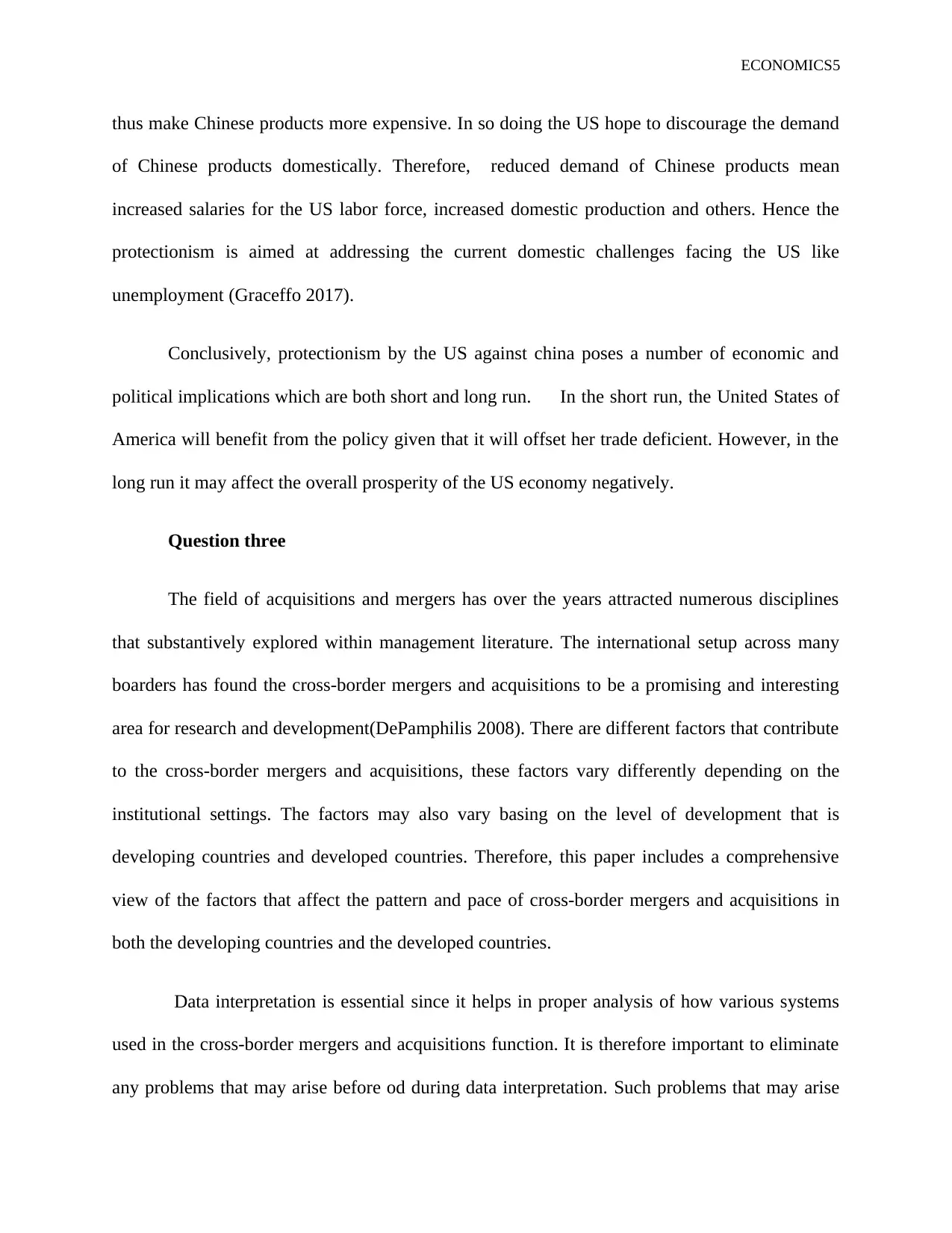
ECONOMICS5
thus make Chinese products more expensive. In so doing the US hope to discourage the demand
of Chinese products domestically. Therefore, reduced demand of Chinese products mean
increased salaries for the US labor force, increased domestic production and others. Hence the
protectionism is aimed at addressing the current domestic challenges facing the US like
unemployment (Graceffo 2017).
Conclusively, protectionism by the US against china poses a number of economic and
political implications which are both short and long run. In the short run, the United States of
America will benefit from the policy given that it will offset her trade deficient. However, in the
long run it may affect the overall prosperity of the US economy negatively.
Question three
The field of acquisitions and mergers has over the years attracted numerous disciplines
that substantively explored within management literature. The international setup across many
boarders has found the cross-border mergers and acquisitions to be a promising and interesting
area for research and development(DePamphilis 2008). There are different factors that contribute
to the cross-border mergers and acquisitions, these factors vary differently depending on the
institutional settings. The factors may also vary basing on the level of development that is
developing countries and developed countries. Therefore, this paper includes a comprehensive
view of the factors that affect the pattern and pace of cross-border mergers and acquisitions in
both the developing countries and the developed countries.
Data interpretation is essential since it helps in proper analysis of how various systems
used in the cross-border mergers and acquisitions function. It is therefore important to eliminate
any problems that may arise before od during data interpretation. Such problems that may arise
thus make Chinese products more expensive. In so doing the US hope to discourage the demand
of Chinese products domestically. Therefore, reduced demand of Chinese products mean
increased salaries for the US labor force, increased domestic production and others. Hence the
protectionism is aimed at addressing the current domestic challenges facing the US like
unemployment (Graceffo 2017).
Conclusively, protectionism by the US against china poses a number of economic and
political implications which are both short and long run. In the short run, the United States of
America will benefit from the policy given that it will offset her trade deficient. However, in the
long run it may affect the overall prosperity of the US economy negatively.
Question three
The field of acquisitions and mergers has over the years attracted numerous disciplines
that substantively explored within management literature. The international setup across many
boarders has found the cross-border mergers and acquisitions to be a promising and interesting
area for research and development(DePamphilis 2008). There are different factors that contribute
to the cross-border mergers and acquisitions, these factors vary differently depending on the
institutional settings. The factors may also vary basing on the level of development that is
developing countries and developed countries. Therefore, this paper includes a comprehensive
view of the factors that affect the pattern and pace of cross-border mergers and acquisitions in
both the developing countries and the developed countries.
Data interpretation is essential since it helps in proper analysis of how various systems
used in the cross-border mergers and acquisitions function. It is therefore important to eliminate
any problems that may arise before od during data interpretation. Such problems that may arise
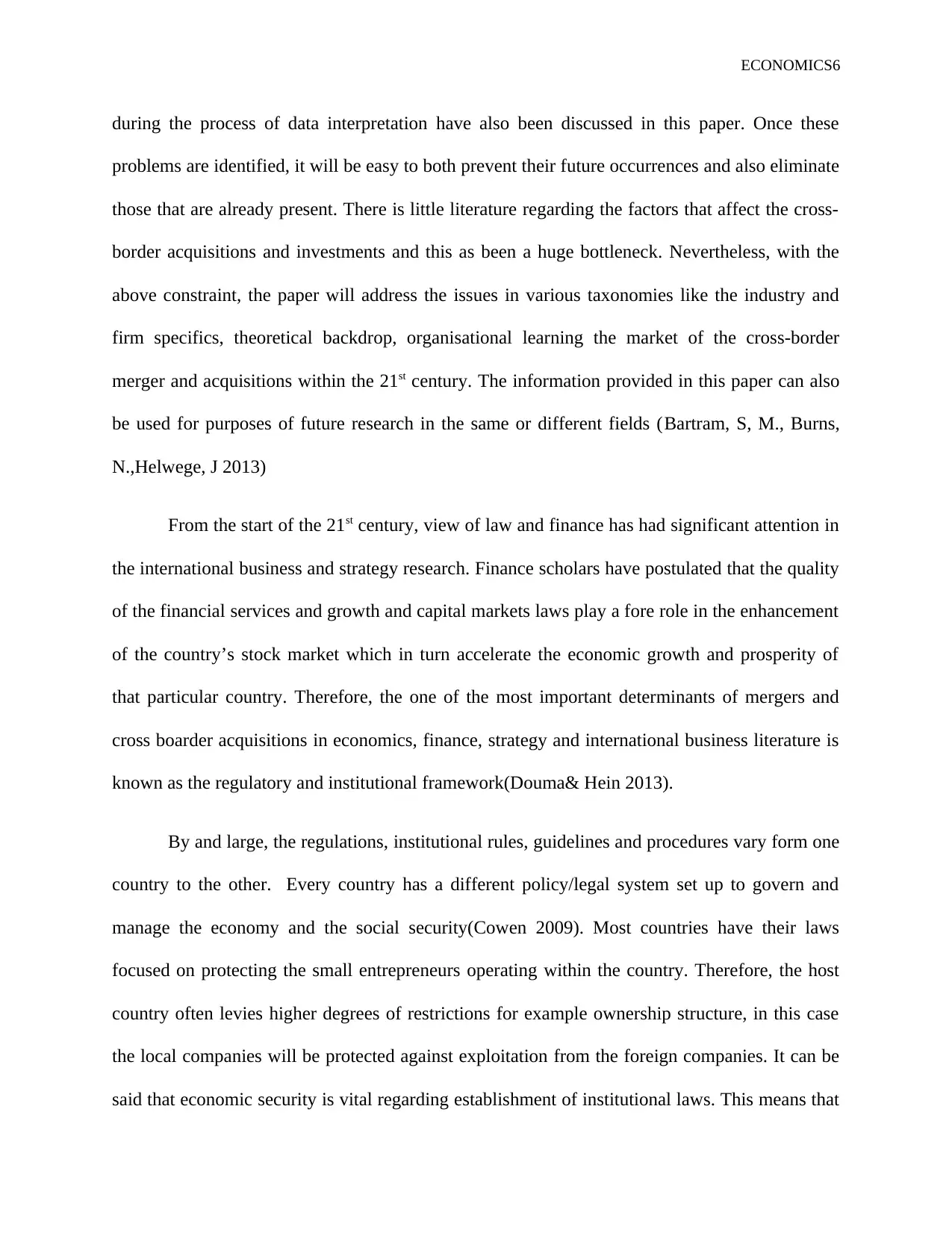
ECONOMICS6
during the process of data interpretation have also been discussed in this paper. Once these
problems are identified, it will be easy to both prevent their future occurrences and also eliminate
those that are already present. There is little literature regarding the factors that affect the cross-
border acquisitions and investments and this as been a huge bottleneck. Nevertheless, with the
above constraint, the paper will address the issues in various taxonomies like the industry and
firm specifics, theoretical backdrop, organisational learning the market of the cross-border
merger and acquisitions within the 21st century. The information provided in this paper can also
be used for purposes of future research in the same or different fields (Bartram, S, M., Burns,
N.,Helwege, J 2013)
From the start of the 21st century, view of law and finance has had significant attention in
the international business and strategy research. Finance scholars have postulated that the quality
of the financial services and growth and capital markets laws play a fore role in the enhancement
of the country’s stock market which in turn accelerate the economic growth and prosperity of
that particular country. Therefore, the one of the most important determinants of mergers and
cross boarder acquisitions in economics, finance, strategy and international business literature is
known as the regulatory and institutional framework(Douma& Hein 2013).
By and large, the regulations, institutional rules, guidelines and procedures vary form one
country to the other. Every country has a different policy/legal system set up to govern and
manage the economy and the social security(Cowen 2009). Most countries have their laws
focused on protecting the small entrepreneurs operating within the country. Therefore, the host
country often levies higher degrees of restrictions for example ownership structure, in this case
the local companies will be protected against exploitation from the foreign companies. It can be
said that economic security is vital regarding establishment of institutional laws. This means that
during the process of data interpretation have also been discussed in this paper. Once these
problems are identified, it will be easy to both prevent their future occurrences and also eliminate
those that are already present. There is little literature regarding the factors that affect the cross-
border acquisitions and investments and this as been a huge bottleneck. Nevertheless, with the
above constraint, the paper will address the issues in various taxonomies like the industry and
firm specifics, theoretical backdrop, organisational learning the market of the cross-border
merger and acquisitions within the 21st century. The information provided in this paper can also
be used for purposes of future research in the same or different fields (Bartram, S, M., Burns,
N.,Helwege, J 2013)
From the start of the 21st century, view of law and finance has had significant attention in
the international business and strategy research. Finance scholars have postulated that the quality
of the financial services and growth and capital markets laws play a fore role in the enhancement
of the country’s stock market which in turn accelerate the economic growth and prosperity of
that particular country. Therefore, the one of the most important determinants of mergers and
cross boarder acquisitions in economics, finance, strategy and international business literature is
known as the regulatory and institutional framework(Douma& Hein 2013).
By and large, the regulations, institutional rules, guidelines and procedures vary form one
country to the other. Every country has a different policy/legal system set up to govern and
manage the economy and the social security(Cowen 2009). Most countries have their laws
focused on protecting the small entrepreneurs operating within the country. Therefore, the host
country often levies higher degrees of restrictions for example ownership structure, in this case
the local companies will be protected against exploitation from the foreign companies. It can be
said that economic security is vital regarding establishment of institutional laws. This means that
⊘ This is a preview!⊘
Do you want full access?
Subscribe today to unlock all pages.

Trusted by 1+ million students worldwide

ECONOMICS7
the policy framework of a given country in relation to foreign trade i.e. (imports and exports) and
investments helps in determination of the 25sucess of the foreign market strategies for entry for
example joint ventures, exporting, licensing FDI, and most importantly acquisitions.
Nevertheless, countries with a common law have laws that strongly protect the activities and the
presence of investors in those particular countries, this in in contrast with the civil law countries
like France where share holder protection is too weak under such laws(Cartwright and
Schoenberg 2006).
Much research has been put on understanding what drives the U.K domestic merger
waves, few scholars have put emphasis on the driving forces throughout the world. It is
important to study suck kind of forces since these merger waves are taking over(Coispeau and
Luo 2015). These merger waves are divided into three categories i.e. neoclassical, mis-valuation
and strategic theories. Neoclassical theories have much emphasis technological shocks and
importance of deregulation at an industrial level
The theories predict that in a society with rational agents, company level shocks lead to
ownership or reallocation of capital towards higher productivity firms and this leads to
generation of a merger wave. For the strategic theories, they largely focus on the lack of targets
with a certain relationship to the acquirers. In this case all the potential acquirers are given a
chance to participate in the bidding of targets simultaneously. It is possible since acquirers
imperfectly compete over time for the scarce targets(Fleuriet 2008). Mis-evaluation focuses on
the level of heterogeneity; this is in view of the overall value of all the traded assets by various
agent’s ant a particular period of time. A model was developed where managers are fully rational
and take advantage of the stocks available to acquire firms that are run by other managers in a
the policy framework of a given country in relation to foreign trade i.e. (imports and exports) and
investments helps in determination of the 25sucess of the foreign market strategies for entry for
example joint ventures, exporting, licensing FDI, and most importantly acquisitions.
Nevertheless, countries with a common law have laws that strongly protect the activities and the
presence of investors in those particular countries, this in in contrast with the civil law countries
like France where share holder protection is too weak under such laws(Cartwright and
Schoenberg 2006).
Much research has been put on understanding what drives the U.K domestic merger
waves, few scholars have put emphasis on the driving forces throughout the world. It is
important to study suck kind of forces since these merger waves are taking over(Coispeau and
Luo 2015). These merger waves are divided into three categories i.e. neoclassical, mis-valuation
and strategic theories. Neoclassical theories have much emphasis technological shocks and
importance of deregulation at an industrial level
The theories predict that in a society with rational agents, company level shocks lead to
ownership or reallocation of capital towards higher productivity firms and this leads to
generation of a merger wave. For the strategic theories, they largely focus on the lack of targets
with a certain relationship to the acquirers. In this case all the potential acquirers are given a
chance to participate in the bidding of targets simultaneously. It is possible since acquirers
imperfectly compete over time for the scarce targets(Fleuriet 2008). Mis-evaluation focuses on
the level of heterogeneity; this is in view of the overall value of all the traded assets by various
agent’s ant a particular period of time. A model was developed where managers are fully rational
and take advantage of the stocks available to acquire firms that are run by other managers in a
Paraphrase This Document
Need a fresh take? Get an instant paraphrase of this document with our AI Paraphraser
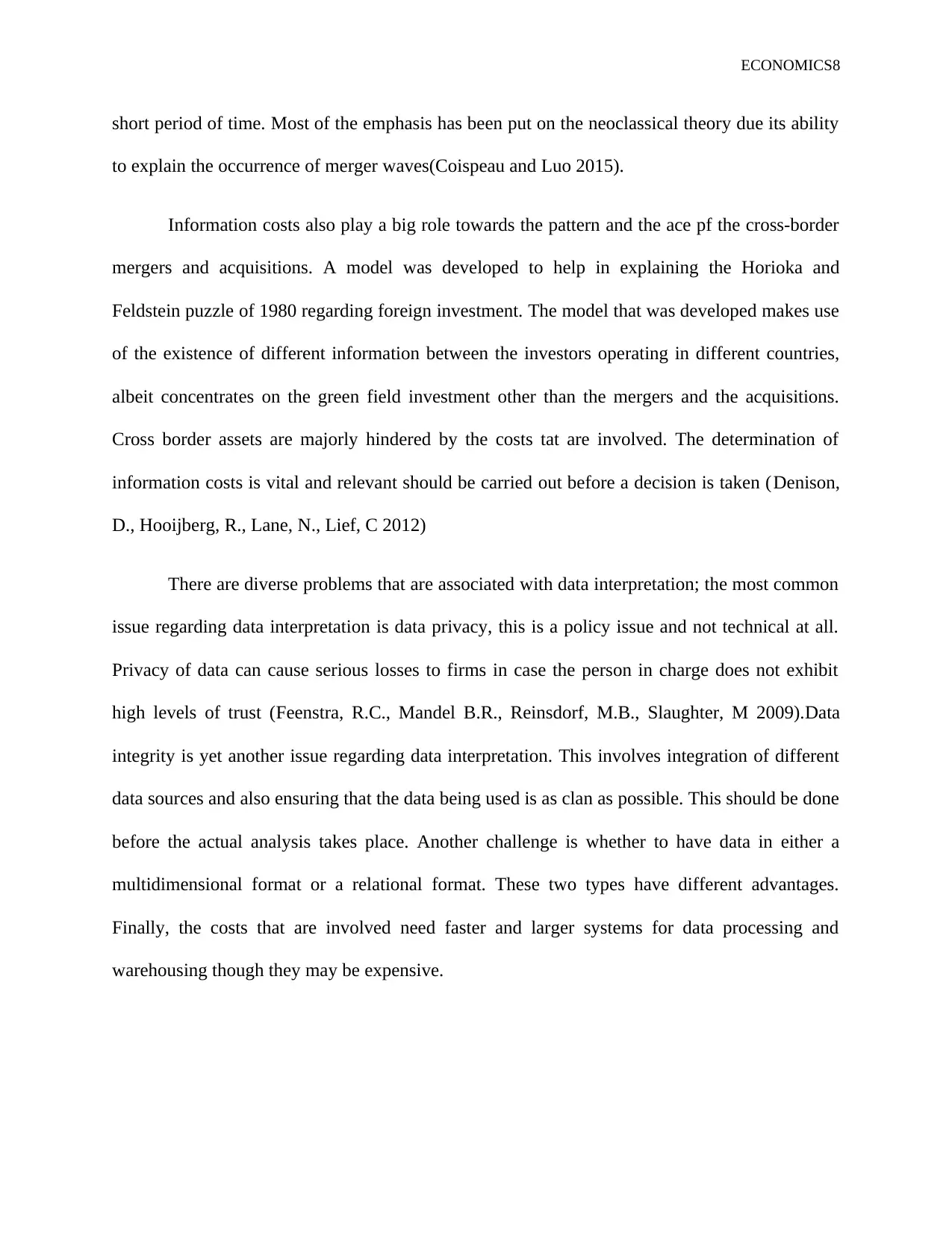
ECONOMICS8
short period of time. Most of the emphasis has been put on the neoclassical theory due its ability
to explain the occurrence of merger waves(Coispeau and Luo 2015).
Information costs also play a big role towards the pattern and the ace pf the cross-border
mergers and acquisitions. A model was developed to help in explaining the Horioka and
Feldstein puzzle of 1980 regarding foreign investment. The model that was developed makes use
of the existence of different information between the investors operating in different countries,
albeit concentrates on the green field investment other than the mergers and the acquisitions.
Cross border assets are majorly hindered by the costs tat are involved. The determination of
information costs is vital and relevant should be carried out before a decision is taken (Denison,
D., Hooijberg, R., Lane, N., Lief, C 2012)
There are diverse problems that are associated with data interpretation; the most common
issue regarding data interpretation is data privacy, this is a policy issue and not technical at all.
Privacy of data can cause serious losses to firms in case the person in charge does not exhibit
high levels of trust (Feenstra, R.C., Mandel B.R., Reinsdorf, M.B., Slaughter, M 2009).Data
integrity is yet another issue regarding data interpretation. This involves integration of different
data sources and also ensuring that the data being used is as clan as possible. This should be done
before the actual analysis takes place. Another challenge is whether to have data in either a
multidimensional format or a relational format. These two types have different advantages.
Finally, the costs that are involved need faster and larger systems for data processing and
warehousing though they may be expensive.
short period of time. Most of the emphasis has been put on the neoclassical theory due its ability
to explain the occurrence of merger waves(Coispeau and Luo 2015).
Information costs also play a big role towards the pattern and the ace pf the cross-border
mergers and acquisitions. A model was developed to help in explaining the Horioka and
Feldstein puzzle of 1980 regarding foreign investment. The model that was developed makes use
of the existence of different information between the investors operating in different countries,
albeit concentrates on the green field investment other than the mergers and the acquisitions.
Cross border assets are majorly hindered by the costs tat are involved. The determination of
information costs is vital and relevant should be carried out before a decision is taken (Denison,
D., Hooijberg, R., Lane, N., Lief, C 2012)
There are diverse problems that are associated with data interpretation; the most common
issue regarding data interpretation is data privacy, this is a policy issue and not technical at all.
Privacy of data can cause serious losses to firms in case the person in charge does not exhibit
high levels of trust (Feenstra, R.C., Mandel B.R., Reinsdorf, M.B., Slaughter, M 2009).Data
integrity is yet another issue regarding data interpretation. This involves integration of different
data sources and also ensuring that the data being used is as clan as possible. This should be done
before the actual analysis takes place. Another challenge is whether to have data in either a
multidimensional format or a relational format. These two types have different advantages.
Finally, the costs that are involved need faster and larger systems for data processing and
warehousing though they may be expensive.
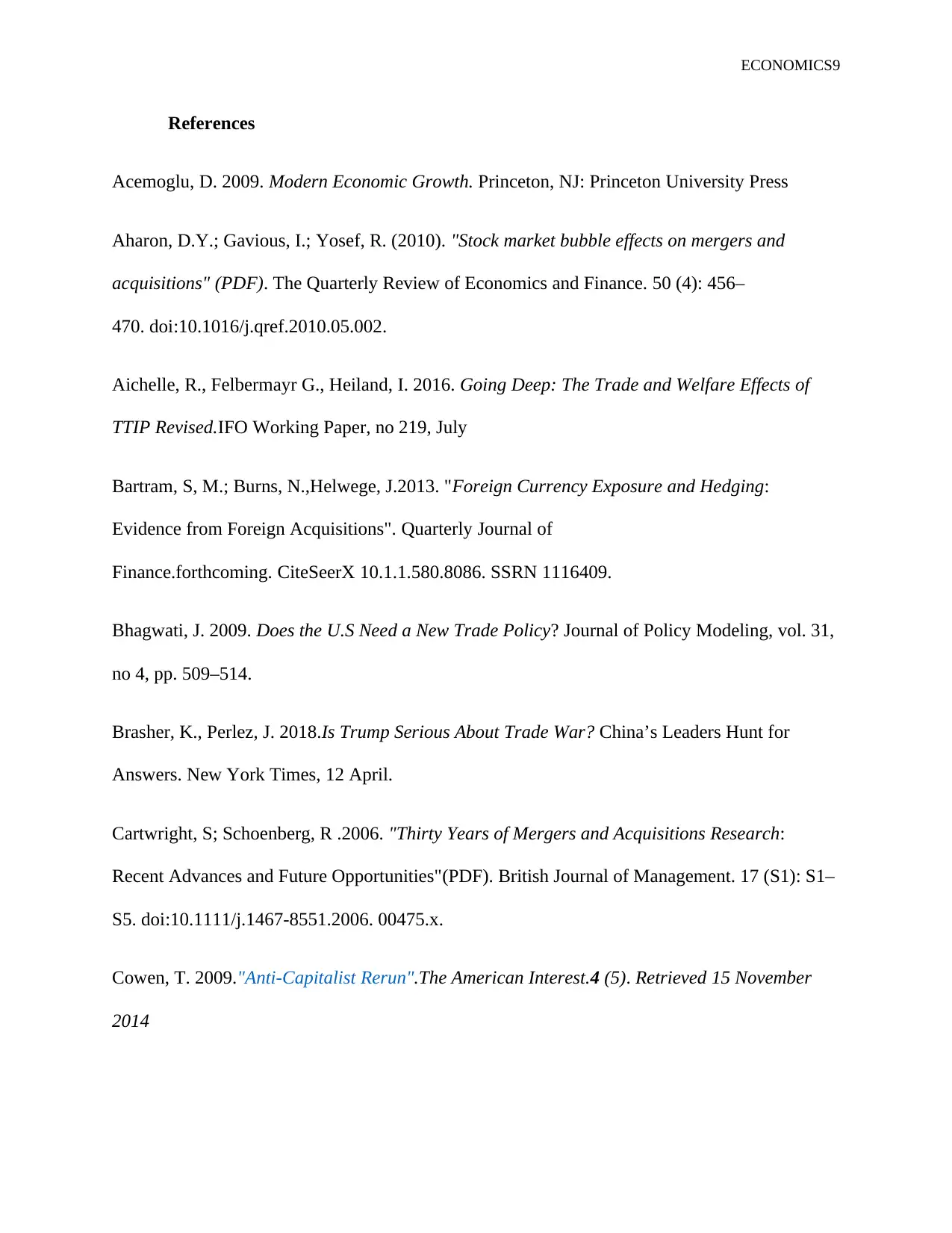
ECONOMICS9
References
Acemoglu, D. 2009. Modern Economic Growth. Princeton, NJ: Princeton University Press
Aharon, D.Y.; Gavious, I.; Yosef, R. (2010). "Stock market bubble effects on mergers and
acquisitions" (PDF). The Quarterly Review of Economics and Finance. 50 (4): 456–
470. doi:10.1016/j.qref.2010.05.002.
Aichelle, R., Felbermayr G., Heiland, I. 2016. Going Deep: The Trade and Welfare Effects of
TTIP Revised.IFO Working Paper, no 219, July
Bartram, S, M.; Burns, N.,Helwege, J.2013. "Foreign Currency Exposure and Hedging:
Evidence from Foreign Acquisitions". Quarterly Journal of
Finance.forthcoming. CiteSeerX 10.1.1.580.8086. SSRN 1116409.
Bhagwati, J. 2009. Does the U.S Need a New Trade Policy? Journal of Policy Modeling, vol. 31,
no 4, pp. 509–514.
Brasher, K., Perlez, J. 2018.Is Trump Serious About Trade War? China’s Leaders Hunt for
Answers. New York Times, 12 April.
Cartwright, S; Schoenberg, R .2006. "Thirty Years of Mergers and Acquisitions Research:
Recent Advances and Future Opportunities"(PDF). British Journal of Management. 17 (S1): S1–
S5. doi:10.1111/j.1467-8551.2006. 00475.x.
Cowen, T. 2009."Anti-Capitalist Rerun".The American Interest.4 (5). Retrieved 15 November
2014
References
Acemoglu, D. 2009. Modern Economic Growth. Princeton, NJ: Princeton University Press
Aharon, D.Y.; Gavious, I.; Yosef, R. (2010). "Stock market bubble effects on mergers and
acquisitions" (PDF). The Quarterly Review of Economics and Finance. 50 (4): 456–
470. doi:10.1016/j.qref.2010.05.002.
Aichelle, R., Felbermayr G., Heiland, I. 2016. Going Deep: The Trade and Welfare Effects of
TTIP Revised.IFO Working Paper, no 219, July
Bartram, S, M.; Burns, N.,Helwege, J.2013. "Foreign Currency Exposure and Hedging:
Evidence from Foreign Acquisitions". Quarterly Journal of
Finance.forthcoming. CiteSeerX 10.1.1.580.8086. SSRN 1116409.
Bhagwati, J. 2009. Does the U.S Need a New Trade Policy? Journal of Policy Modeling, vol. 31,
no 4, pp. 509–514.
Brasher, K., Perlez, J. 2018.Is Trump Serious About Trade War? China’s Leaders Hunt for
Answers. New York Times, 12 April.
Cartwright, S; Schoenberg, R .2006. "Thirty Years of Mergers and Acquisitions Research:
Recent Advances and Future Opportunities"(PDF). British Journal of Management. 17 (S1): S1–
S5. doi:10.1111/j.1467-8551.2006. 00475.x.
Cowen, T. 2009."Anti-Capitalist Rerun".The American Interest.4 (5). Retrieved 15 November
2014
⊘ This is a preview!⊘
Do you want full access?
Subscribe today to unlock all pages.

Trusted by 1+ million students worldwide
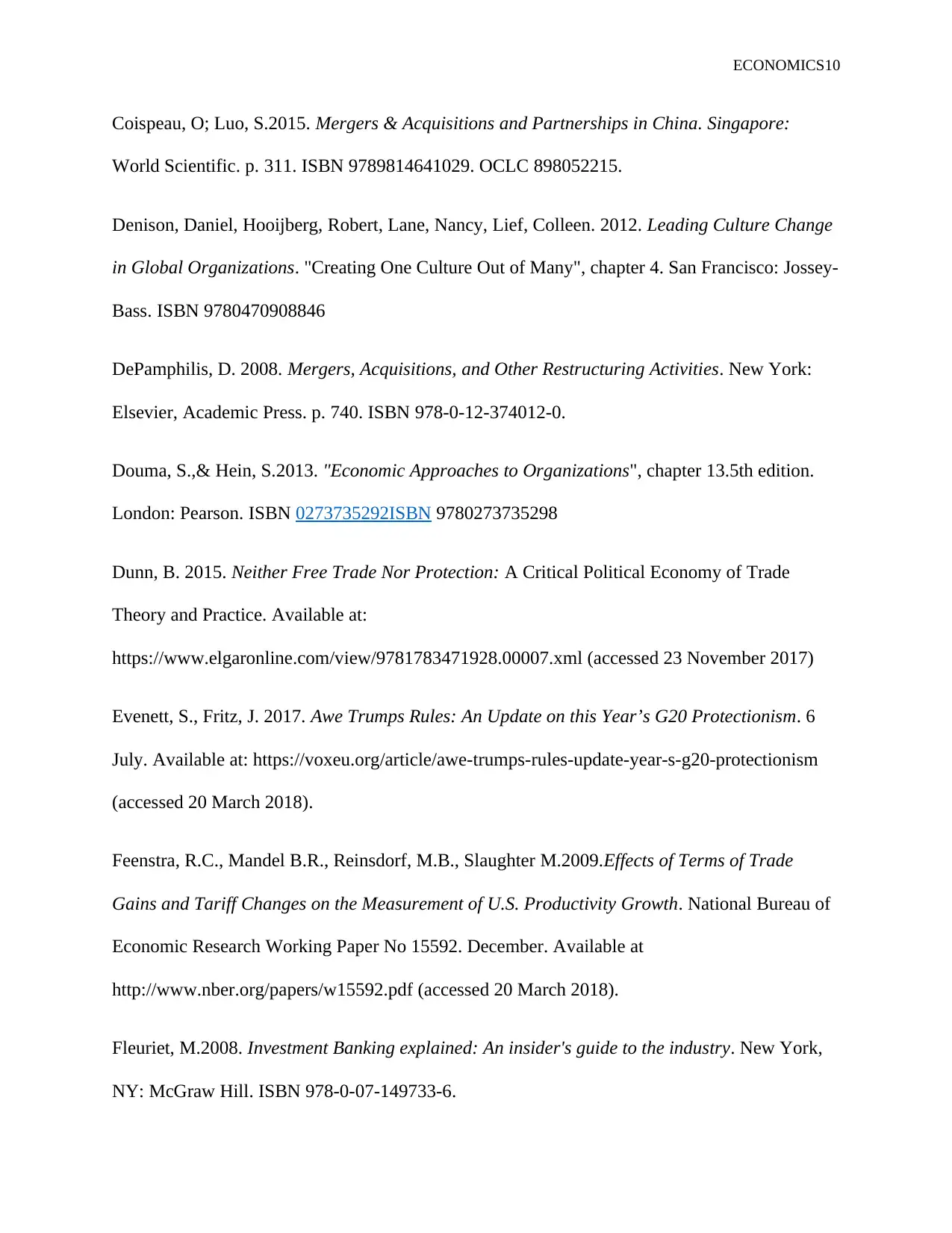
ECONOMICS10
Coispeau, O; Luo, S.2015. Mergers & Acquisitions and Partnerships in China. Singapore:
World Scientific. p. 311. ISBN 9789814641029. OCLC 898052215.
Denison, Daniel, Hooijberg, Robert, Lane, Nancy, Lief, Colleen. 2012. Leading Culture Change
in Global Organizations. "Creating One Culture Out of Many", chapter 4. San Francisco: Jossey-
Bass. ISBN 9780470908846
DePamphilis, D. 2008. Mergers, Acquisitions, and Other Restructuring Activities. New York:
Elsevier, Academic Press. p. 740. ISBN 978-0-12-374012-0.
Douma, S.,& Hein, S.2013. "Economic Approaches to Organizations", chapter 13.5th edition.
London: Pearson. ISBN 0273735292ISBN 9780273735298
Dunn, B. 2015. Neither Free Trade Nor Protection: A Critical Political Economy of Trade
Theory and Practice. Available at:
https://www.elgaronline.com/view/9781783471928.00007.xml (accessed 23 November 2017)
Evenett, S., Fritz, J. 2017. Awe Trumps Rules: An Update on this Year’s G20 Protectionism. 6
July. Available at: https://voxeu.org/article/awe-trumps-rules-update-year-s-g20-protectionism
(accessed 20 March 2018).
Feenstra, R.C., Mandel B.R., Reinsdorf, M.B., Slaughter M.2009.Effects of Terms of Trade
Gains and Tariff Changes on the Measurement of U.S. Productivity Growth. National Bureau of
Economic Research Working Paper No 15592. December. Available at
http://www.nber.org/papers/w15592.pdf (accessed 20 March 2018).
Fleuriet, M.2008. Investment Banking explained: An insider's guide to the industry. New York,
NY: McGraw Hill. ISBN 978-0-07-149733-6.
Coispeau, O; Luo, S.2015. Mergers & Acquisitions and Partnerships in China. Singapore:
World Scientific. p. 311. ISBN 9789814641029. OCLC 898052215.
Denison, Daniel, Hooijberg, Robert, Lane, Nancy, Lief, Colleen. 2012. Leading Culture Change
in Global Organizations. "Creating One Culture Out of Many", chapter 4. San Francisco: Jossey-
Bass. ISBN 9780470908846
DePamphilis, D. 2008. Mergers, Acquisitions, and Other Restructuring Activities. New York:
Elsevier, Academic Press. p. 740. ISBN 978-0-12-374012-0.
Douma, S.,& Hein, S.2013. "Economic Approaches to Organizations", chapter 13.5th edition.
London: Pearson. ISBN 0273735292ISBN 9780273735298
Dunn, B. 2015. Neither Free Trade Nor Protection: A Critical Political Economy of Trade
Theory and Practice. Available at:
https://www.elgaronline.com/view/9781783471928.00007.xml (accessed 23 November 2017)
Evenett, S., Fritz, J. 2017. Awe Trumps Rules: An Update on this Year’s G20 Protectionism. 6
July. Available at: https://voxeu.org/article/awe-trumps-rules-update-year-s-g20-protectionism
(accessed 20 March 2018).
Feenstra, R.C., Mandel B.R., Reinsdorf, M.B., Slaughter M.2009.Effects of Terms of Trade
Gains and Tariff Changes on the Measurement of U.S. Productivity Growth. National Bureau of
Economic Research Working Paper No 15592. December. Available at
http://www.nber.org/papers/w15592.pdf (accessed 20 March 2018).
Fleuriet, M.2008. Investment Banking explained: An insider's guide to the industry. New York,
NY: McGraw Hill. ISBN 978-0-07-149733-6.
Paraphrase This Document
Need a fresh take? Get an instant paraphrase of this document with our AI Paraphraser
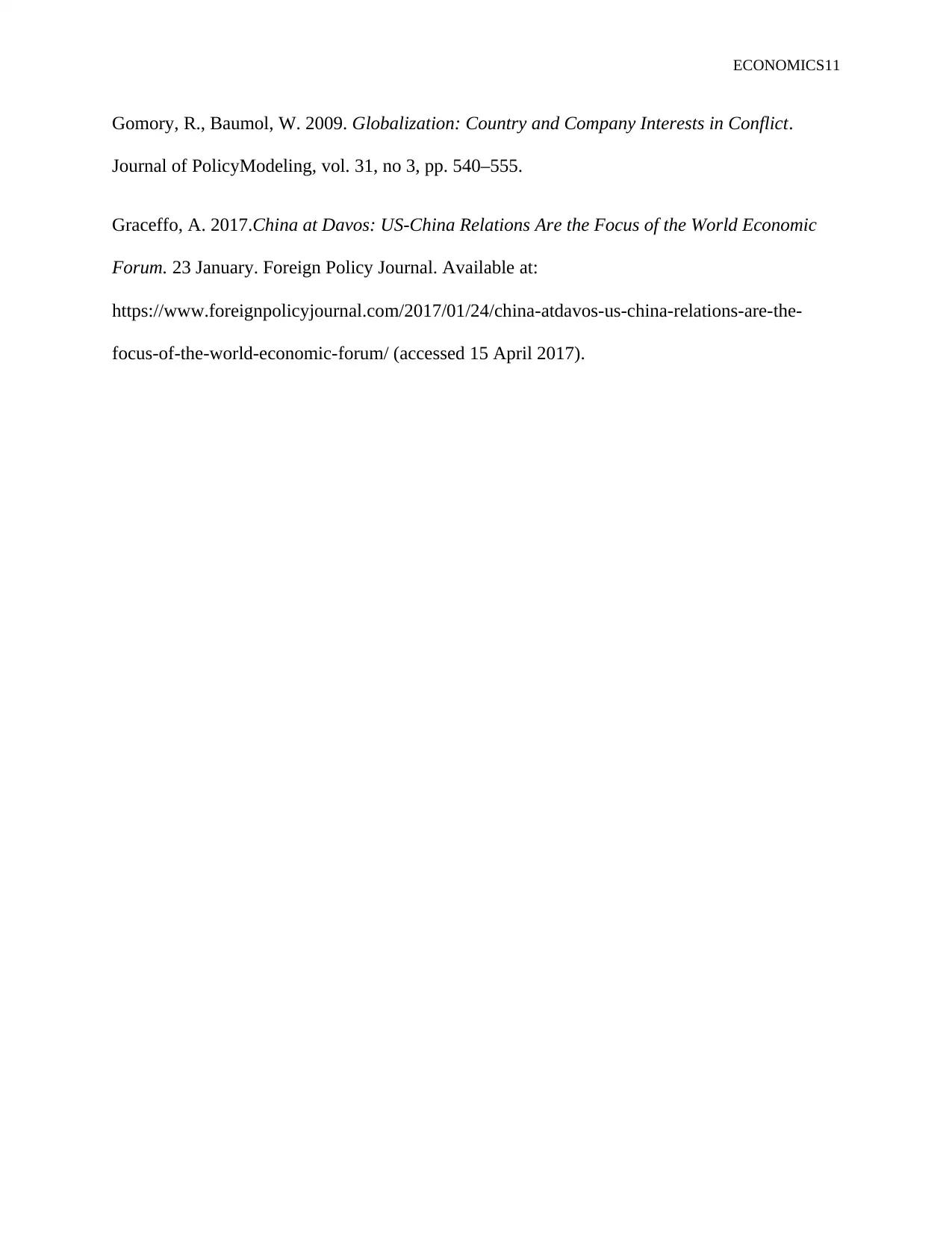
ECONOMICS11
Gomory, R., Baumol, W. 2009. Globalization: Country and Company Interests in Conflict.
Journal of PolicyModeling, vol. 31, no 3, pp. 540–555.
Graceffo, A. 2017.China at Davos: US-China Relations Are the Focus of the World Economic
Forum. 23 January. Foreign Policy Journal. Available at:
https://www.foreignpolicyjournal.com/2017/01/24/china-atdavos-us-china-relations-are-the-
focus-of-the-world-economic-forum/ (accessed 15 April 2017).
Gomory, R., Baumol, W. 2009. Globalization: Country and Company Interests in Conflict.
Journal of PolicyModeling, vol. 31, no 3, pp. 540–555.
Graceffo, A. 2017.China at Davos: US-China Relations Are the Focus of the World Economic
Forum. 23 January. Foreign Policy Journal. Available at:
https://www.foreignpolicyjournal.com/2017/01/24/china-atdavos-us-china-relations-are-the-
focus-of-the-world-economic-forum/ (accessed 15 April 2017).
1 out of 11
Related Documents
Your All-in-One AI-Powered Toolkit for Academic Success.
+13062052269
info@desklib.com
Available 24*7 on WhatsApp / Email
![[object Object]](/_next/static/media/star-bottom.7253800d.svg)
Unlock your academic potential
Copyright © 2020–2025 A2Z Services. All Rights Reserved. Developed and managed by ZUCOL.





